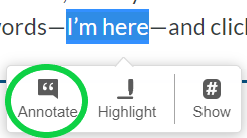Lesson 8 Navigation and Synchronous E-Learning
8-5 Making an Annotation
Wouldn’t it be neat to have a space where you can also add your notes to the course text and see the notations of others as well and co-create learning together. We’ve created an online course book for ELID510 with all of the weekly lesson pages using UW Pressbooks. We embedded this course book into Canvas for use in these remaining sessions, and you also have access to the webbook version after you finish the certificate.
We have enabled Hypothes.is, the social annotation tool for the web[1]. You will need to log in to your Hypothesis account to see our group annotations. ![]()
 In the upper right-hand corner, of this space, you’ll notice an area with 3 icons. This is the Hypothesis Annotation sidebar.
In the upper right-hand corner, of this space, you’ll notice an area with 3 icons. This is the Hypothesis Annotation sidebar.
- The left arrow (less than symbol) opens the sidebar.
- The eyeball icon toggles to hide or show highlights.
- The bent corner icon is used for page notes.
And here’s how you can use hypothesis to co-create through annotation.

There are 3 types of interactions you can do on a page with Hypothesis: create an annotation, add a page note, and create a highlight. The first time you log in to your Hypothesis sidebar, you will see the How to get started box with a brief explanation on the features.
If Public is showing in your sidebar, anyone visiting the webbook (even without an account) will see your annotations.
If our ELID group name is showing in your sidebar, your annotations will be visible to all group members.
Page notes, as the name applies, do not apply to a specific text selection. Read more about the Varieties of Hypothesis Annotations and their Uses from the Hypothes.is blog.
Highlights are always private to only you. If you add a comment or tag to the highlight, it will become an annotation and visible to others.
➡For your first annotation, leave your name and location so that we know you’re here with us.

- Please select these words—I’m here—and click the Annotate button.
- Post your comment to the ELID group, not Public.

- Keyboard users can use Hypothesis too. See more at Accessibility at Hypothesis. ↵
